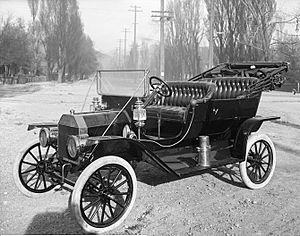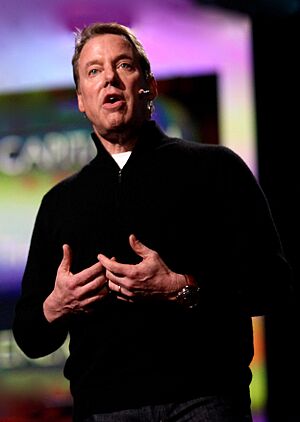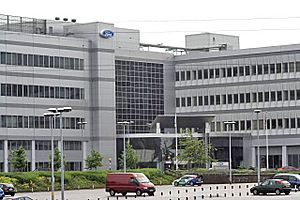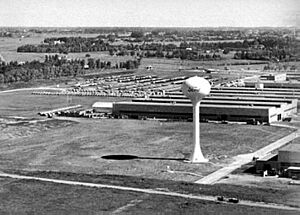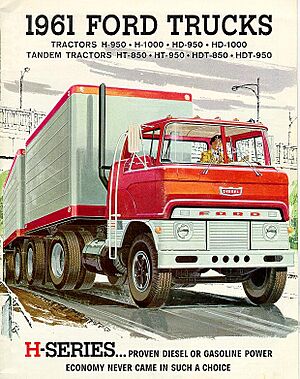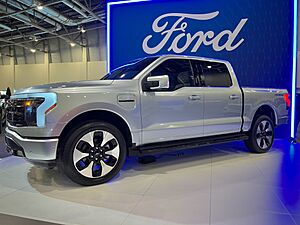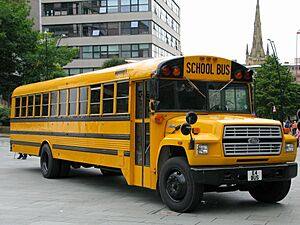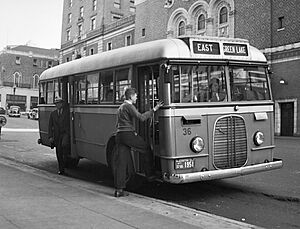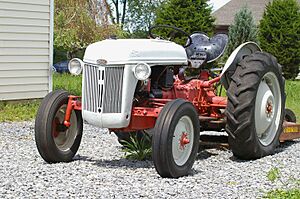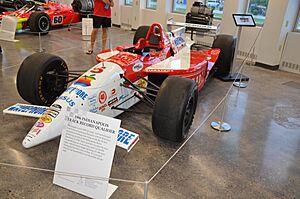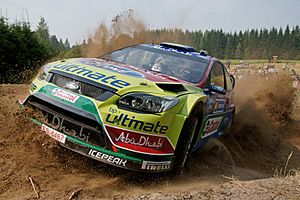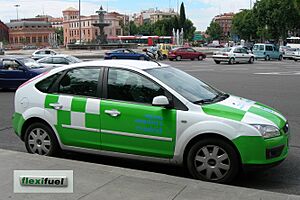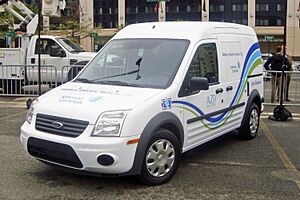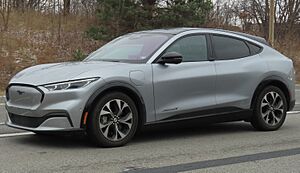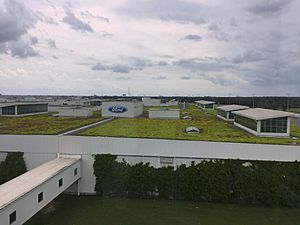Ford Motor Company facts for kids
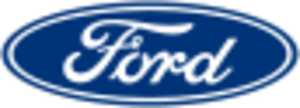 |
|
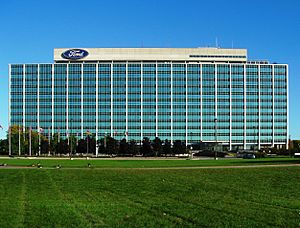
Ford World Headquarters in Dearborn, Michigan
|
|
| Public | |
| Traded as | |
| Industry | Automotive |
| Predecessor | Henry Ford Company |
| Founded | June 16, 1903 in Detroit, Michigan, US |
| Founder | Henry Ford |
| Headquarters | Ford World Headquarters,
,
US
|
|
Area served
|
Worldwide |
|
Key people
|
|
| Products |
|
| Brands |
|
|
Production output
|
|
| Services |
|
| Revenue | |
|
Operating income
|
|
| Total assets | |
| Total equity | |
| Owner | Ford family (2% equity; 40% voting power) |
|
Number of employees
|
171,000 (2024) |
| Divisions |
|
| Subsidiaries |
List
International
Finance
Other
|
The Ford Motor Company, often just called Ford, is a huge American company that makes cars. Its main office is in Dearborn, Michigan, in the United States. Henry Ford started the company, and it officially began on June 16, 1903.
Ford sells cars and trucks under the Ford name. It also sells fancy cars under its Lincoln brand. The company's shares are traded on the New York Stock Exchange using the symbol "F". The Ford family still controls the company, even though they own a smaller part of it. They have a lot of say in how the company is run.
Ford changed how cars were made by using assembly lines. This made it possible to build cars much faster and cheaper. By 1914, these methods were known worldwide as Fordism. Ford used to own car brands like Jaguar and Land Rover, but sold them to Tata Motors in 2008. It also owned Volvo from 1999 to 2010. In 2010, Ford stopped making cars under its Mercury brand.
Ford is the second-largest car maker in America, after General Motors. It is the sixth-largest in the world, based on how many vehicles it made in 2022. Ford became a public company in 1956. However, the Ford family kept 40% of the voting power through special shares. During a tough time for car companies from 2008 to 2010, Ford managed to stay strong without needing government help. Ford has since become profitable again. In 2023, Ford made 4.4 million cars and had about 177,000 employees around the world.
Ford's Journey: A Look at Its History
How Ford Started and Grew (20th Century)
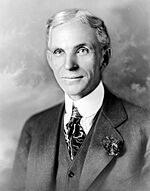
Before the Ford Motor Company, Henry Ford tried to start another car company in 1901. That company later became Cadillac Motor Company. In 1903, the Ford Motor Company officially began. It started in an old factory with $28,000 from twelve investors. Two of the most important investors were John and Horace Dodge, who later started the Dodge Brothers Motor Vehicle Company.
The first president of Ford was a banker named John S. Gray. He was chosen to make investors feel safe that Henry Ford wouldn't leave this new company. In its early days, Ford made only a few cars a day. Workers built each car by hand using parts from other companies. But within ten years, Ford became a leader in using and improving the assembly line. This allowed them to make many more cars.
Henry Ford was 39 years old when he started the Ford Motor Company. It grew into one of the biggest and most successful companies in the world. The Ford family has controlled it for over 100 years.
The first gasoline car was made in 1885 by Karl Benz in Germany. Henry Ford helped make cars affordable for everyone. He did this by introducing the first moving assembly line in 1913 at the Ford factory in Highland Park.
Between 1903 and 1908, Ford made several car models like the A, B, C, and F. They sold hundreds or a few thousand of these each year. In 1908, Ford launched the Model T. This car was mass-produced, meaning millions were sold over almost 20 years. In 1927, the Model T was replaced by the Model A. This was the first car to have safety glass in the windshield. In 1932, Ford also made the first affordable car with a V8 engine.

To compete with other car brands, Ford created the Mercury brand in 1939. These were more expensive cars than the regular Fords. Henry Ford also bought the Lincoln Motor Company in 1922. This was to compete in the luxury car market.
In 1929, the government of the Soviet Union asked Ford to help set up the Gorky Automobile Plant in Russia. This plant first made Ford Model A and AA cars. This helped Russia become more industrialized, which was important during World War II.
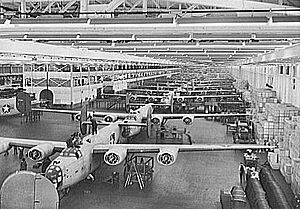
During World War II, the United States government chose Ford to mass-produce the Consolidated B-24 Liberator bomber at its Willow Run factory. Ford's branches in Germany and France also made military vehicles for Germany's war efforts. Some of Ford's operations in Germany used forced labor during this time.
In 1951, Ford opened a science lab in Michigan. This led to Ford's work in superconductivity research. In 1964, Ford Research Labs invented a SQUID, which is a special device used in science.
Ford cared about safety. In 1956, they offered the Lifeguard safety package. This included a special steering wheel, and for the first time, front and rear seatbelts. In 1957, Ford added child-proof door locks to its cars.
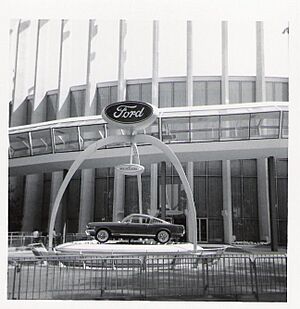
The Ford Mustang was first shown on April 17, 1964, at the 1964 New York World's Fair. In 1965, Ford added a seat belt reminder light to its cars.
In the 1980s, Ford launched many successful vehicles around the world. They used the slogan "Have you driven a Ford, lately?" to attract new customers. Ford also bought Jaguar Cars in 1990 and Aston Martin in 1994. In the mid-to-late 1990s, Ford sold many cars because the American economy was strong and gas prices were low.
As the new century began, Ford faced challenges. High healthcare costs for older workers, rising gas prices, and a weaker economy meant fewer sales and less profit. Most of the company's profits came from giving loans to people buying cars through Ford Motor Credit Company.
Ford in the 21st Century: Adapting and Innovating
By 2005, Ford and GM were having financial trouble. This was due to high healthcare costs, rising gas prices, and fewer people buying their SUVs. In late 2005, Bill Ford, the chairman, asked Mark Fields to create a plan to make the company profitable again. This plan, called The Way Forward, was announced in January 2006. It involved making the company smaller, stopping production of some cars, closing 14 factories, and cutting 30,000 jobs.
Ford started making new types of vehicles, like "Crossover SUVs." These cars are built on car platforms, making them lighter. Ford also worked on hybrid electric car technology. They even partnered with an electricity company, Southern California Edison, to study how plug-in hybrids could work with the electric power grid.
William Clay Ford Jr., Henry Ford's great-grandson, became executive chairman in 1998. In 2001, he also became the CEO, the first Ford family member to lead the company since 1982. In 2006, Alan Mulally became president and CEO, with Bill Ford remaining as executive chairman.
In 2006, Ford had its biggest loss ever, $12.7 billion. They thought it would take until 2009 to make a profit again. But in 2007, they surprised everyone by making a $750 million profit. In June 2008, Ford sold its Jaguar and Land Rover brands to Tata Motors for $2.3 billion.
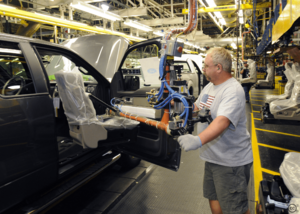
During the 2008–2010 automotive industry crisis, Ford's CEO Alan Mulally said that Ford hoped to have enough money to keep going. He also said that if other car companies failed, it would hurt Ford. Ford supported other carmakers in getting government loans. Ford did not need a government loan itself, but asked for a $9 billion credit line as a backup.
In January 2009, Ford reported a record loss of $14.6 billion for the previous year. However, the company had enough money to keep operating. By April 2009, Ford had reduced its debt by $9.9 billion. This helped Ford make a $2.7 billion profit in 2009, its first full-year profit in four years. By 2012, Ford's financial health had improved greatly.
In 2012, Ford sold its climate control parts business. In November 2012, Ford announced that CEO Alan Mulally would stay until 2014. They also named Mark Fields as the new chief operating officer.
In April 2016, Ford announced a big plan to update its engineering and headquarters campuses in Dearborn. This ten-year project would double the number of Ford employees working there to 24,000. The new buildings would be designed to be energy-efficient.

In January 2017, Ford CEO Mark Fields announced that Ford canceled plans for a new plant in Mexico. Instead, they would invest $700 million in Michigan to create 700 new jobs. The Ford Focus car would now be made in an existing plant in Mexico.
Also in 2017, Ford started developing a new urban campus in Detroit's Corktown neighborhood. They bought and renovated The Factory building. This new site focuses on developing self-driving and electric vehicle technology. Ford also bought the historic Michigan Central Station, planning to make it the center of their Corktown campus. Ford expected to move 2,500 employees to the campus. In February 2017, Ford bought most of Argo AI, a self-driving car startup.
In May 2017, Ford announced job cuts worldwide to improve profits. They aimed to cut $3 billion in costs and reduce salaried workers in Asia and North America by almost 10%. Jim Hackett replaced Mark Fields as CEO. Mr. Hackett had been in charge of Ford Smart Mobility, a group that explored car-sharing and self-driving projects.
In April 2018, Ford announced it would stop selling most passenger cars in North America over the next four years. They decided to focus mainly on pickup trucks and SUVs, except for the Mustang. Ford had planned to sell a crossover version of the Focus in the U.S., but canceled it due to tariffs on Chinese goods.
In March 2020, during the COVID-19 pandemic, Ford and other carmakers agreed to temporarily shut down factories. By March 24, Ford announced that production in the US, Canada, and Mexico would not restart as planned. In the first three months of 2020, Ford's sales dropped by 15%, leading to a $2 billion loss.
On January 6, 2021, Ford reported a 9.8% drop in sales for the last three months of 2020. In April 2021, Ford said it would offer COVID-19 vaccines to its employees at company locations.
In March 2022, Ford announced it would reorganize into three separate divisions. Ford Model E focuses on electric vehicles. Ford Blue focuses on gasoline-powered vehicles. The existing commercial division was renamed Ford Pro, focusing on vehicle sales and service. In August 2022, Ford announced layoffs of about 3,000 employees. These cuts mainly affected divisions in the US, Canada, and India. CEO Jim Farley said this would help the company prepare for the future of electric, software-heavy vehicles.
In February 2023, Ford announced it would cut 3,800 jobs across Europe, mostly engineers in Germany and the UK. Ford also said its electric vehicle business lost $3 billion before taxes in the past two years and expected a similar loss in 2023. Ford Model E is expected to become profitable by 2026.
In April 2023, the United Kingdom approved Ford's BlueCruise technology. This assisted driving system allows Ford drivers to take their hands off the wheel on certain roads. It uses sensors and cameras to control speed, track speed limits, and keep a safe distance from other cars. It also has an eye-tracking system. If the driver stops looking at the road, the car will slow down. This technology was first offered in the 2023 electric Mustang Mach-E SUV. This system is a "level 2" automation, meaning the driver is still responsible for the car. In August 2024, police in Pennsylvania filed charges against a driver who caused a fatal accident while using BlueCruise.
In November 2024, Ford announced more job cuts, 800 in the UK and 2,900 in Germany, to reduce costs.
Ford Logo Evolution
How Ford Operates Around the World
| Region | share |
|---|---|
| United States | 66.4% |
| Canada | 7.6% |
| United Kingdom | 5.1% |
| Mexico | 1.6% |
| Other countries | 19.6% |
Ford has factories all over the world. These include places like the United States, Canada, Mexico, China, India, the United Kingdom, Germany, Turkey, Brazil, Argentina, Australia, and South Africa. Ford even helped the Soviet Union build the Russian carmaker GAZ.
Ford in North America
In May 2010, Ford's sales increased by 23% for the month. About 37% of these sales were to large groups like companies or governments (called "fleet sales"). By July 2010, fleet sales for Ford had risen by 35%.
Ford in Europe
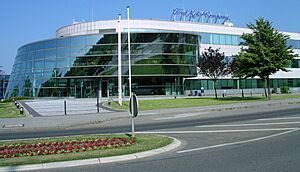
At first, Ford in Germany and Ford in Britain made different car models. But by 1965, they started making common models like the Ford Transit van and later the Ford Escort. Over time, many models were produced in other European countries like Belgium and Spain, as well as Germany.
In February 2002, Ford stopped making cars in the UK. This was the first time in 90 years that Ford cars were not made in Britain. However, they continued to make the Transit van, engines, and transmissions there. Ford also has a joint factory in Turkey called Ford Otosan. This factory makes the Ford Transit Connect van and larger Transit vans.
In 2008, Ford bought most of Automobile Craiova in Romania. This plant started making the Ford Transit Connect in 2009. In 2022, Ford Otosan bought Ford Romania.
The 1959 Ford Anglia was a unique-looking small family car in Europe. It was very popular with British buyers. It was replaced by the Escort in 1967. The third version of the Ford Escort came out in 1980. This marked Ford's shift from rear-wheel-drive cars to front-wheel-drive hatchbacks.
The Focus was launched in 1998. It was known for its bold design and great handling. It sold very well until the next generation came out in 2004.
The 1982 Ford Sierra replaced the popular Cortina and Taunus models. Its modern, aerodynamic design was very different from older, boxy cars. It was very popular everywhere it was sold.
Ford entered the mini-car market in 1976 with the Ford Fiesta hatchback. Most of these were made in Valencia, Spain, and the Fiesta sold in huge numbers from the start.
On October 24, 2012, Ford announced it would close its assembly plant in Genk, Belgium, by the end of 2014.
In March 2022, Ford announced it was stopping its joint business in Russia because of the 2022 Russian invasion of Ukraine. By October 2022, Ford sold its share in the joint venture and left the Russian market.
Ford in Asia
Ford started its first car-making partnership in China in 2001. They invested $4.9 billion to expand their car lineup and double production in China. Ford had 2.5% of the Chinese market in 2013. Ford's presence in Asia was traditionally smaller, mainly in Malaysia, Singapore, Hong Kong, the Philippines, and Taiwan. In Taiwan, Ford has had a joint company with Lio Ho since the 1970s.
Ford started assembling cars in Thailand in 1960 but left in 1976. They returned in 1995 with a joint company called Auto Alliance. This factory still makes passenger cars.
In 1967, Ford partnered with Hyundai in South Korea. They built the European Ford Cortina until 1974. Ford then worked with Kia, which built cars designed with Mazda. Ford sold the Ford Festiva from 1988 to 1993 and the Ford Aspire from 1994 to 1997 in the United States. Ford later sold its interest in Kia to Hyundai in 1998.
As of 2020, Ford sells the Explorer, Mondeo, and Mustang in South Korea. They also sell Lincoln models like the Aviator and Continental there.
Ford India began making cars in 1998. They started with the Ford Escort, which was later replaced by the Ford Ikon in 2001. They also added models like the Fusion and Fiesta. In 2019, Ford and Mahindra & Mahindra formed a joint company to make and sell Ford cars in India. In September 2021, Ford India announced it would close both its assembly plants.
Ford's presence in the Middle East has been small. Saudi Arabia, Kuwait, and the United Arab Emirates are the biggest markets. Ford also started in Egypt in 1926. In 2004, Ford sold 30,000 cars in the region.
Ford in South America
In South America, Ford mainly operates in Brazil, Argentina, and Ford Andina (Colombia, Ecuador, and Venezuela). Ford has over 18,000 employees and seven factories in the region. In 1987, Ford Brazil and Ford Argentina joined with Volkswagen Group's operations there to form a new company called Autolatina. This company was dissolved in 1995.
In early 2021, Ford's Brazil branch announced it would stop all production in the country over a few months.
Ford in Africa
In Africa, Ford has been strongest in South Africa. Ford in South Africa started by importing car parts from Canada to assemble them. They later used models from the UK and Australia. In the mid-1980s, Ford merged with a rival company to form South African Motor Corporation (Samcor).
After apartheid ended in 1994, Ford bought a 45% stake in Samcor. This later became a fully owned Ford company again, called the Ford Motor Company of Southern Africa. Ford now sells a local sedan version of the Fiesta and the Focus there.
Ford's Research and Innovation
Ford has technology research centers in:
- Dearborn, Michigan
- Palo Alto, California
- Aachen, Germany
- Nanjing, China
The Ford Research and Innovation Center in Palo Alto opened in 2012. In January 2015, Ford announced plans to greatly expand its work there.
Ford has a "chief futurist" position, which started in 2019. This person's job is to predict future trends. Jennifer Brace currently holds this role.
What Ford Makes and Offers
Cars and Trucks
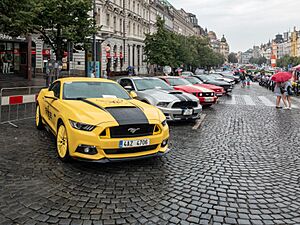
Ford Motor Company sells many different cars under the Ford brand worldwide. It also sells luxury cars under the Lincoln brand in the United States. Ford has sold vehicles under other names in the past. The Mercury brand was introduced in 1939 but stopped production in 2011 due to low sales. In 1958, Ford launched the Edsel brand, but it also stopped production in 1960 because of poor sales.
Ford bought the British sports car maker Aston Martin in 1989 but sold most of it in 2007. Ford bought Volvo Cars of Sweden in 1999 and sold it in 2010.
In November 2008, Ford reduced its ownership in Mazda of Japan. By November 2010, Ford reduced its stake even further to just 3%. Ford and Mazda still work together by sharing technology. In 2015, Ford sold its remaining shares in Mazda.
Ford sold the British companies Jaguar and Land Rover to Tata Motors of India in March 2008.
On April 25, 2018, Ford announced it would stop making most of its car models in North America. They decided to focus mainly on pickup trucks and SUVs, with the Mustang being the only car model to remain.
Ford has been making trucks since 1908, starting with the Ford Model TT. Many of Ford's truck businesses in other countries have closed. The European truck division of Ford of Britain became part of the Iveco group in 1986. Ford's last big European truck models were the Transcontinental and the Cargo. In 1996, Ford sold the rights to its heavy trucks division to Freightliner Trucks.
For 1999, Ford briefly stopped making medium-duty trucks. In 2001, they started a joint company with Navistar International called Blue Diamond Truck Company LLC. They would make medium-duty trucks together.
In Europe, Ford makes the Ford Transit van, which can carry a lot of weight. The Ford Transit Connect is a smaller van, and the Ford Ranger is a pickup truck.
Buses
Ford used to make complete buses. Today, they mostly make the chassis (the frame and engine) for buses. In North America, the E-Series is used for small school buses. The F-650 is used for commercial buses. In the past, the medium-duty B700 was a popular chassis for school bus makers.
In 1936, Ford introduced the Ford Transit Bus. These were small buses with bodies made by other companies. After 1946, Ford stopped making transit buses in North America.
In Europe, Ford makes the Ford Transit Minibus. This bus can carry 12, 15, or 17 passengers.
Tractors
The "Henry Ford and Son Company" started making Fordson tractors in 1907. They were made in Michigan, Ireland, and England. They were also produced in Russia starting in 1924.
Ford re-entered the tractor market in 1939 with the Ford N-series tractors. The Ford 8N, introduced in 1947, became the most popular tractor ever in North America. Production of the N line ended in 1952.
In 1986, Ford bought Sperry-New Holland, a company that made farm equipment. They formed Ford-New Holland. This company was later bought by Fiat in 1993 and became New Holland.
Financial Services and Parts
Ford offers car loans and financing through Ford Motor Credit Company.
Ford's FoMoCo parts division sells car parts under the Motorcraft brand name. They also spun off their parts division into a separate company called Visteon.
Ford's Brands
Current Brands
| Origin | Marque | Estab. | Added | Markets |
|---|---|---|---|---|
| Ford | 1903 | 1903 | Global | |
| Lincoln | 1917 | 1922 | North America, Middle East, China, South Korea | |
| Motorcraft | 1972 | 1972 | Global |
Past Brands
| Origin | Marque | Years | Markets | Fate |
|---|---|---|---|---|
| Autolite | 1961–1973 | Global | Sold to Bendix Corporation | |
| Comet | 1960–1961 | North America | Merged with Mercury | |
| Continental | 1956–1986 | North America | Discontinued | |
| Edsel | 1957–1960 | North America | Discontinued | |
| Fordson | 1917–1964 | North America, Ireland, U.K. | Discontinued | |
| Mercury | 1939–2011 | North America, Middle East | Discontinued | |
| Merkur | 1985–1989 | North America | Discontinued | |
| Meteor | 1949–1976 | Canada | Discontinued | |
| Monarch | 1946–1961 | Canada | Discontinued | |
| Frontenac | 1960 | Canada | Discontinued | |
| Troller | 2007–2021 | Brazil | Company closed by Ford Brasil | |
| FPV | 2002–2014 | Australia | Discontinued | |
| Mazda | 1974–2015 | Global | Sold shares | |
| TH!NK | 1999–2003 | North America, Europe | Sold to Kamkorp | |
| Volvo | 1999–2010 | Global | Sold to Geely | |
| Matford | 1934–1940 | France | Joint company with Mathis ended | |
| De Tomaso | 1971–1974 | Global | Sold to Alejandro de Tomaso | |
| Moto Guzzi | 1973–1974 | Global | Sold to Alejandro de Tomaso | |
| Benelli | 1972–1974 | Global | Sold to Alejandro de Tomaso | |
| AC Cars | 1986–1992 | U.K. | 50% stake sold | |
| Aston Martin | 1989–2007 | Global | Sold to a private group | |
| Jaguar | 1989–2008 | Global | Sold to Tata Motors | |
| Land Rover | 2000–2008 | Global | Sold to Tata Motors | |
| Thames | 1939–1965 | Europe, Canada | Discontinued |
Ford in Racing: Speed and Competition
Winning Big in World Championships
Ford is one of only three American car makers to win titles in international racing championships. Ford won the World Sportscar Championship three times (1966, 1967, and 1968). In the World Rally Championship, Ford won four World Drivers' Championships (1979, 1981, 2017, and 2018) and four World Manufacturers' Championships (1979, 2006, 2007, and 2017). As an engine supplier, Ford also won 13 Formula One World Drivers' Championships and 10 Formula One World Constructors' Championships.
Ford is also one of only three car makers to achieve the "Triple Crown of Motorsport." This means winning the Indianapolis 500, 24 Hours of Le Mans, and Monaco Grand Prix. Ford did this as an engine maker by winning the 1968 Monaco Grand Prix.
IndyCar Racing
IndyCars with Ford engines first raced in 1935. Ford engines, including the DFX engine developed by Cosworth, have won the Indianapolis 500 eighteen times. In 1996, Arie Luyendyk set speed records at the Indianapolis 500 with a Ford Cosworth XB engine. These records still stand today.
Formula One Racing
Ford was very involved in Formula One for many years, supplying engines to many teams from 1967 to 2004. These engines were designed by Cosworth, which Ford owned from 1998 to 2004. Ford-branded engines won 176 Grand Prix races. Ford entered Formula One as a team in 2000 under the Jaguar Racing name. After five difficult seasons, Ford left Formula One after the 2004 season.
Ford announced that it will return to Formula One in 2026. They will partner with Red Bull Powertrains to supply power units to Red Bull Racing and their second team.
Stock Car Racing (NASCAR)
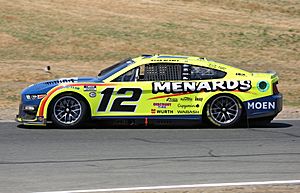
Ford is one of three car makers in NASCAR's top racing series. Major Ford teams include RFK Racing and Team Penske. Ford cars like the Mustang GT and the F-150 truck are used in these races. Ford has won eight manufacturer championships in the Cup Series. In 2013, Ford earned its 1,000th victory in the Cup Series.
Rally Racing
Ford has a long history in rallying. They have been active in the World Rally Championship since 1973. Ford won the manufacturers' title in 1979 with drivers like Hannu Mikkola. Since 1999, Ford has used different versions of the Ford Focus WRC with great success. In 2006 and 2007, Ford won the manufacturers' world championship again.
Sports Car Racing
Ford sports cars have been famous in racing since 1964. The Ford GT40 famously won the 24 Hours of Le Mans four times (1966, 1967, 1968, and 1969). It is the only American car to ever win this important race overall. Ford also won four titles in the World Sportscar Championship with the GT40.
Ford Mustang in Racing

The Ford Mustang has been one of Ford's most successful sports cars in racing. It helped Ford win the Trans-Am Championship in 1966, 1967, and 1970. Ford also won the IMSA GTO Championship in 1985 and 1986 with Mustangs. Ford dominated Trans-Am in the 1990s. In 2005, the Ford Mustang FR500C won the championship in the Rolex Koni Challenge Series.
Ford's Environmental Efforts
Flexible Fuel Vehicles
Flexible fuel vehicles can run on different types of fuel, from pure gasoline to mixtures like E85 (85% ethanol and 15% gasoline). One challenge in selling these cars in the U.S. is the lack of gas stations that offer these special fuels. However, efforts are growing to increase the production and distribution of E85 fuels.
Electric Cars and Hybrids
Hybrid Electric Vehicles
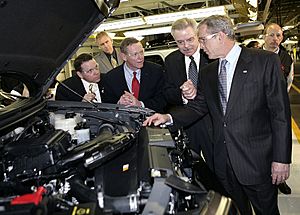
In 2004, Ford and Toyota agreed to share patents for hybrid technology. In 2004, Ford introduced the Escape Hybrid. This was Ford's first hybrid electric vehicle and the first hybrid electric SUV. It was also the first hybrid that could run on E85 fuel.
In 2005, Ford aimed to make 250,000 hybrids a year by 2010. But by mid-2006, they realized they couldn't reach that goal due to high costs and not enough parts. Instead, Ford focused on developing new hybrid technologies with Volvo in Britain.
In September 2007, Ford partnered with Southern California Edison to study how plug-in hybrids would work with the electric grid. Ford converted some Ford Escape Hybrids into plug-in hybrids for this project.
In March 2009, Ford launched hybrid versions of the Ford Fusion Hybrid and the Mercury Milan Hybrid in the United States. By June 2012, Ford had sold 200,000 full hybrids in the U.S. since 2004. As of November 2014, Ford was the world's second-largest maker of hybrids after Toyota Motor Corporation.
Plug-in Electric Vehicles
As of April 2024, Ford makes several plug-in electric vehicles. These include the Ford Escape/Kuga PHEV, Ford Ranger PHEV, Ford Mustang Mach-E, Ford F-150 Lightning, Ford Explorer EV (Europe), Ford E-Transit/Tourneo Courier, Ford E-Transit Custom and the Ford E-Transit.
Bill Ford was one of the first top executives to regularly use a battery electric vehicle, a Ford Ranger EV. Ford also made electric postal vans. Ford stopped making electric Ranger pickup trucks and ordered them to be destroyed, but changed their mind after protests.
From 2009 to 2011, Ford offered the Ford TH!NK car. Ford stopped production and tried to get all the cars back to destroy them. After protests from people who leased them, Ford sent the cars back to Norway for sale.
In 2017, Ford CEO Mark Fields announced that the company would invest $4.5 billion in developing more plug-in electric vehicles by 2020.
The 2010–2012 Azure Transit Connect Electric was an all-electric van made with Azure Dynamics.
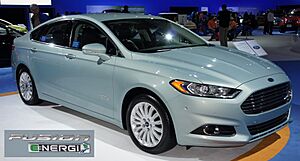
The 2011–2018 Ford Focus Electric was an all-electric car based on the gasoline Ford Focus. Sales began in the U.S. in December 2011.
The 2012–2017 Ford C-Max Energi was a plug-in hybrid released in the U.S. in October 2012. It was followed by the Ford Fusion Energi (2013–2020). Both models used the same engine technology.
In October 2017, Ford created Team Edison to lead its new efforts in the EV market. This team planned for a small electric SUV with a 300-mile range by 2020.
On November 17, 2019, the Mustang Mach-E was introduced. It went on sale in December 2020 as a 2021 model. The Mustang Mach-E is made in Mexico. In June 2022, Ford's CFO said the Mustang Mach-E was no longer profitable due to rising material costs.
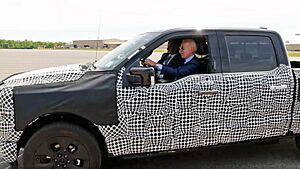
On May 19, 2021, Ford showed a new electric pickup truck, the F-150 Lightning. The first F-150 Lightning was made on April 18, 2022. Ford adjusted its 2024 production plans for the F-150 Lightning, cutting them in half because sales were lower than expected. In 2022, Ford started making its E-Transit electric cargo vans in Missouri.
As a result of a 2019 partnership with Volkswagen, Ford started developing electric vehicles for Europe using Volkswagen's electric car platform. The first Ford product based on this platform is the Ford Explorer EV, introduced in March 2023. It is made in Germany. In August 2023, Ford delayed Explorer EV deliveries to 2024 due to new battery rules.
In March 2022, Ford increased its focus on electric vehicles by creating Ford Model E. This division handles Ford's electric vehicle business. Ford Model E is expected to be profitable by 2026. In June 2022, Ford announced plans to change how its dealerships work. They want to create an e-commerce platform where customers can buy electric vehicles at set prices. Ford also said it planned to spend $3.7 billion to hire 6,200 union workers to staff several factories. This is to help them sell 2 million electric vehicles annually by 2026.
In May 2023, Ford announced plans to use the North American Charging System (NACS) for its electric vehicles. New Ford electric vehicles made after 2024 will have NACS charging ports. Older Ford electric models will be able to use NACS chargers with an adapter. This will give them access to over 12,000 chargers in North America.
Hydrogen Power
Ford also studies fuel cell-powered electric cars. They have shown hydrogen-fueled internal combustion engines. These vehicles reduce air pollution and noise.
Ford has started making hydrogen-powered shuttle buses. These buses use hydrogen instead of gasoline in a regular engine. They are used at airports and convention centers. At the 2006 Greater Los Angeles Auto Show, Ford showed a hydrogen fuel cell version of its Explorer SUV. This Fuel cell Explorer can travel about 350 miles, which was a long distance for a fuel cell vehicle at the time.
Making Cars More Fuel Efficient
In July 2008, Ford announced plans to make more fuel-efficient cars faster. They planned to change three existing pickup truck and SUV factories to make small cars. This included converting plants in Michigan, Mexico, and Kentucky to make cars like the Ford Fiesta by 2011. Ford also planned to bring six of its European small cars to North America.
Ford of Europe developed the ECOnetic program to make cars more fuel-efficient and produce less CO2. Instead of using hybrid technology like the Toyota Prius, ECOnetic improves existing diesel engines. These cars use less fuel and have lower emissions.
In 2000, Ford announced a plan to improve the average mileage of its SUVs by 25% by 2005. However, they later said they couldn't reach this goal due to market conditions and costs.
For the 2007 model year, Ford had thirteen U.S. models that got 30 miles per gallon or better on the highway. Ford claimed to have reduced almost three million pounds of smog-forming emissions from their U.S. cars and light trucks from 2004 to 2006.
Efficient Buildings
As part of updating the Ford River Rouge Complex, Ford unveiled a 10.4-acre living roof in 2010. This roof covers part of the Dearborn Truck plant and is made of sedum plants. The sedum helps collect and clean rainwater and keeps the building cooler, saving energy.
In 2016, Ford announced a ten-year plan to renovate its Dearborn campus. This plan involves combining offices and labs into fewer, larger buildings. These buildings will be designed to be very energy-efficient and will include wetlands and park areas. The new campus also has multi-story parking garages with solar panels on the roofs and a new natural gas power plant.
Ford's Sponsorships
Ford sponsors many events and sports places in the U.S. These include the Ford Center in Evansville, Indiana, and Ford Field in Detroit.
The company has also been a big sponsor of the UEFA Champions League for over twenty years. They also sponsor Sky media channel's coverage of Premier League football.
Between 1994 and 1999, Ford was the main sponsor for the German football club 1. FC Köln.
Sales Numbers in the US
| Calendar Year | US sales | Market share
of US sales |
|---|---|---|
| 1997 | 3,877,458 | 25.0% |
| 1998 | 3,922,604 | 24.5% |
| 1999 | 4,163,369 | 23.9% |
| 2000 | 4,202,820 | 23.6% |
| 2001 | 3,971,364 | 22.7% |
| 2002 | 3,623,709 | 21.2% |
| 2003 | 3,483,719 | 20.5% |
| 2004 | 3,331,676 | 19.3% |
| 2005 | 3,153,875 | 18.1% |
| 2006 | 2,901,090 | 17.0% |
| 2007 | 2,507,366 | 15.2% |
| 2008 | 1,988,376 | 14.7% |
| 2009 | 1,620,888 | 15.3% |
| 2010 | 1,935,462 | 16.4% |
| 2011 | 2,143,101 | 16.4% |
| 2012 | 2,250,165 | 15.2% |
| 2013 | 2,493,918 | 15.7% |
| 2014 | 2,480,942 | 14.7% |
| 2015 | 2,613,162 | 14.6% |
| 2016 | 2,614,697 | 14.6% |
| 2017 | 2,586,715 | 14.7% |
| 2018 | 2,497,318 | 14.1% |
| 2019 | 2,422,698 | 13.8% |
| 2020 | 2,044,744 | 13.7% |
| 2021 | 1,905,955 | 12.4% |
More About Ford
- The Henry Ford, a museum
- Chariot (company)
- Detroit Automobile Company
- Dodge v. Ford Motor Company
- Firestone and Ford tire controversy
- List of automobile manufacturers of the United States
See also
 In Spanish: Ford Motor Company para niños
In Spanish: Ford Motor Company para niños


